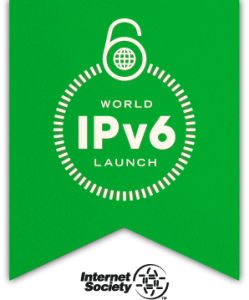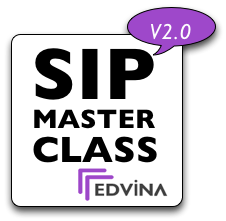The new Edvina SIP Masterclass – Stockholm and Miami this fall!
Edvina today launches a new training class, based on years of experience of inhouse and public classes in SIP, Asterisk and Kamailio/OpenSER. The new class focuses on the SIP protocol and the Kamailio Open Source SIP server. By combining lessons on the core SIP standard with the Kamailio implementation and labs, the students will learn interactively and get real configurations to bring home. The new class will launch in October in Stockholm, Sweden and in December in Miami, Florida, USA.
– “We’ve updated the training materials during a series of in-house trainings during 2011 and 2012, which means that the material is almost totally new compared with the original class held seven years ago.” says Olle E. Johansson, Edvina’s founder and the teacher in the classes. “We’ve added more labs and more information about SIP presence and security. For students, this is an upgrade that fits everyone that has worked with Asterisk, FreeSwitch or Yate for many years and wants to learn how to scale and add new SIP services to their solutions.”
Experienced teacher guiding the way
Olle has many years of experience in trainings. He wrote the first Asterisk Bootcamp trainings in 2005 and was the author behind the Digium dCAP certification for Asterisk. Prior to that, he has been doing years of training in TCP/IP networks, from network basics to LDAP directories and SSL/TLS solutions. In addition he’s working as a consultant building large platforms with Kamailio and Asterisk as the primary tools. He has been involved in both Open Source projects since 2002, as a contributor, documentation writer, coder and project member.
From SIP to scalable realtime platforms with Kamailio
This class is built for persons that have used the PBX-class tools like Asterisk, Yate and FreeSwitch and wants to learn how to scale and add new applications like presense and instant messaging to their solution.
The class will spend a lot of time on the SIP standards, then move on to how to implement them using Kamailio – the Open Source SIP server – in combination with other tools. After the class, you will not only know how to operate Kamailio – you will also have a lot of knowledge about how the SIP standard works, what to expect from devices and how to troubleshoot your realtime network.
PS: A special thank you to Redfone Communications in Miami that hosts our training in December!
SIP2012 :: Redefining SIP
Edvina today launched SIP2012 – a project to try to redefine SIP in the eyes of all customers to our industry. We need to go beyond the 10-year old RFC and use all the solutions developed by the IETF and the SIP Forum during 10 years of SIP version 2.0. We’re not defining SIP 3.0 – but trying to combine a set all the specifications added during this time into a reference profile that customers can refer to and use when buying SIP devices – phones, servers, chat clients, PBXs and much more.
What’s the current state?
It’s very hard for customers to clearly specify functionality required. If they refer to RFC 3261 as a base RFC, that would include S/MIME which is almost never implemented. RFC is updated by 13 RFCs, added to by quite a lot of RFCs and there are 5 verified bug reports (ERRATA) against the text in the RFC.
An example: A large bid for a new telephony platform
Let’s start the discussion with an example. One large bid from last year specified the following standards as requirements:
- RFC 3261: SIP version 2.0
- RFC 3263: Locating SIP Servers
- RFC 3550: Real-time Transport Protocol (RTP)
- RFC 3551: RTP Profile for Audio and Video Conferences with minimal control
- RFC 3487: Priority mechanisms for SIP
- RFC 2833 or 4733: DTMF signalling
- RFC 4855/4856: Media Type Registration of RTP Payload Formats
- RFC 3611: RTP Control Protocol Extended Reports
- RFC 5391: RTP Payload format for G711.1
- RFC 3711: The secure Real-time Transport Protocol
- RFC 5246: The Transport Layer Security (TLS) Protocol
- RFC 2475: Diffserv
What is your opinion? Do you have a good specification that could be useful for other people? Please share!
Reference implementations are important!
We encourage Open Source projects to support the profile and take some extra steps to build reference implementations and test them at the SIPit test events, organized by the SIP forum. Edvina will participate and help tests by building self-test platforms where possible, as we’ve done for TLS, SIP Identity, early media and much more during earlier SIPit events.
Kamailio and OverSIP Open Source SIP Servers are working on implementing SIP Outbound, the first part of SIP2012. We need clients that support it so we can test it for interoperability. Please join this effort!
To find out more – click here for the SIP2012 web with a presentation of SIP Outbound – the first part of the SIP2012 profile.
Is SIP the new WebRTC infrastructure?
 SIP celebrates 10 years this summer. When it was created, it was created to become the new infrastructure for Internet-wide realtime communication and collaboration. Based on domains, like e-mail, SIP was built for the Internet. But neither the Internet nor corporate networks was ready for it. Many problems was discovered, like NAT traversal, firewall handling and the quality of the existing networks. They where built for store-and-forward networking, getting a file, sending a file – but not realtime communication.
SIP celebrates 10 years this summer. When it was created, it was created to become the new infrastructure for Internet-wide realtime communication and collaboration. Based on domains, like e-mail, SIP was built for the Internet. But neither the Internet nor corporate networks was ready for it. Many problems was discovered, like NAT traversal, firewall handling and the quality of the existing networks. They where built for store-and-forward networking, getting a file, sending a file – but not realtime communication.
10 years later we see that most of the SIP installations ended up as PSTN-over-IP solutions. SIP addresses are equal to E.164 phone numbers and domain based federations across the Internet is rarely used. We have ended up in a world with VoIP islands that have no interoperability that call each other over the old switch phone network. That was not the vision, that was not the idea driving the development of SIP.
Webrtc- where all the fun happens today!
During this year, we’ve seen a lot of activity around a new communication technology named WebRTC. The idea is to add realtime media – audio, video, file transfer – to every web browser. With a few lines of Javascript you can create an application that calls other browser users. This is of course fun and removes the need to install a soft phone in your device – the cell phone, the tablet or the computer. Every device with a web browser will have realtime communication capabilities. The browser can ask for permission to use the webcam and the audio system and bootstrap communication.
WebRTC – joint development by W3C and the IETF
WebRTC is a joint project between the IETF and the World Wide Web consortium. The W3C defines the Javascript extensions and the IETF the underlying protocols and mechanics. Microsoft, Google, Ericsson and many other companies are involved in the process, like most web browser developer teams – Firefox, Safari, Chrome. The work is progressing quickly, but is not yet done. Many browsers are releasing beta implementations. Google Chrome has invited developers to play with the new API’s and have many interesting projects based on just the simple fact that the webcam is now part of the toolset in the browser. Caleidoscopes, face recognition, games and much more has been developed during Google hacker meetings.
Will WebRTC make SIP a dying system?
There will be millions of WebRTC applications, from games to business communication. As soon as you want to communicate across server borders, there is still the issue of finding the other person and setting up a communication session. You need a protocol to do this. WebRTC only involves setting up the media and describing media capabilities – but there still needs to be a way to exchange these attributes in order to set up a session. If the users are using the same web application, the application will be able to manage the exchange of media attributes. This will work for many applications that wants to enhance the existing service with realtime audio and video. As soon as you want to scale beyond that and communicate with users somewhere else, on a SIP phone or a PSTN device, you need a protocol that opens up for reaching out and setting up a session. SIP is exactly such a protocol, a protocol that operates on a session – finds the other party (or multiple users), sets up the session, manage the session and end the session. SIP and WebRTC are perfect buddies. From a SIP standpoint, there’s not a lot of difference between using the multimedia system in a computer than using it in a browser. From the users standpoint, they’ve already installed the browser. It’s there and simple to use.
SIP with WebRTC fulfills the SIP vision
SIP and WebRTC have the possibility of bringing SIP back to it’s root. We can now build a federated global network, like E-mail. And add security that did not exist in e-mail, so that we can trust the network and use it everywhere we connect our devices. There are already many solutions that will take you beyond telephony-style number-based calls, like the Kamailio SIP proxy and the Zoiper and Blink soft phones that support SIP presence and instant messaging.
Edvina stays on top of these new technologies and are happy to help new and existing customers to navigate in this new communications world!
World IPv6 Launch is today!
 Today is the World IPv6 Launch. This means that thousands of web sites across the world will enable IPv6 access and keep it on. It’s an important start of a change that will mean that IPv6 will be just normal work and hopefully integrated into all projects. At Edvina, we will from now on integrate IPv6 support in our platforms by default. IPv6 support is no longer an extra add-on or something that we only install if the customer asks for it. Building new platforms for TCP/IP means IPv6 included.
Today is the World IPv6 Launch. This means that thousands of web sites across the world will enable IPv6 access and keep it on. It’s an important start of a change that will mean that IPv6 will be just normal work and hopefully integrated into all projects. At Edvina, we will from now on integrate IPv6 support in our platforms by default. IPv6 support is no longer an extra add-on or something that we only install if the customer asks for it. Building new platforms for TCP/IP means IPv6 included.
The World IPv6 Launch is a big step forward for the Internet. Our blog, IPv6 Friday, has covered many aspects of the World IPv6 Launch, what it is and how you should prepare for it.
- May 25, 2012: Oh no! June 6th is coming up faster than expected!
- Apr 13, 2012: No need to go backwards in time, use a reverse web proxy
- Mar 23, 2012: Get ready in time for the World IPv6 Launch
- Jan 20, 2012: Your new goal: The world IPv6 Launch
The blog at IPv6Friday.org keeps getting more readers and generates discussion.
The final Asterisk SIP Masterclass
We’ve been running the Asterisk SIP Masterclass ourselves and with partners (Telespeak in the UK and Avanzada7 in Spain) for many years now. It’s time to run the last show – as always partly with new material. Compared with the very first Asterisk SIP Masterclass I would say that I’ve rewritten 90% of the material. That’s what happens during the class. Students ask questions, you write a slide. The world changes, you write a slide. You realize you’ve been wrong, you delete or edit a slide. It’s a moving target.
The last one of these classes that I teach will be in Barcelona, Spain – June 11th to June 15th.
Why the last one?
 Things change and you need to follow. During the last couple of years I’ve been running many, many in-house trainings and workshops covering both Asterisk, SIP in general and Kamailio. There seems to be more demand for customized trainings that boost a team and help them move forward. I will continue with these trainings, as well as try to come up with other trainings that will run just a few times – more lab oriented possibly. Feedback is as always very welcome.
Things change and you need to follow. During the last couple of years I’ve been running many, many in-house trainings and workshops covering both Asterisk, SIP in general and Kamailio. There seems to be more demand for customized trainings that boost a team and help them move forward. I will continue with these trainings, as well as try to come up with other trainings that will run just a few times – more lab oriented possibly. Feedback is as always very welcome.
What is this class?
From the sales material at http://www.avanzada7.com:
“This class is focusing on building a scalable SIP realtime network. With a combination of theory and practical labs, you will learn how to setup and configure Asterisk and Kamailio – the Open Source SIP server – in a scalable enterprise or service provider network. We will go through various kinds of setups and give you insight in the design of real SIP networks with Asterisk running in enterprise and service provider networks. The teacher Olle Johansson, has many years of experience as an Asterisk developer as well as a community member of Kamailio.org. By spending a week with Olle, you will get a lot of insight into current and future features, bugs and implementation details in a way that’s hard to get otherwise.
Olle is a consultant working with architecture and implementation of large scale communication platforms based on the SIP protocol. He has experience from service providers, universities, call center platforms as well as enterprise solutions. With experience of Unix and TCP/IP networking for over 20 years, he has a lot of insight and knowledge, which he is using as a teacher.”
The class is a five day high level class. You will meet not only myself, but also other students that work with these tools and protocols, learn from them and work together to solve issues in the labs. You need to have a basic knowledge of Linux (how to start/stop applications, edit text files and build applications) and Asterisk. This class is starting at a high level with Asterisk. If you rather use FreeSwitch but want to learn Kamailio that is no problem. You will just have to endure a few slides on Asterisk – but many of the issues apply to FreeSwitch as well as other PBXs too.
![]() The cost is 3.200 Euro ex VAT. Companies outside of EU do not pay VAT as well as companies in EU with a VAT registration number.
The cost is 3.200 Euro ex VAT. Companies outside of EU do not pay VAT as well as companies in EU with a VAT registration number.
If you have any questions or want to register, feel free to contact me on info@edvina.net. Our description of the class covers the content in more detail.
 Looking forward to seeing you in Barcelona!
Looking forward to seeing you in Barcelona!
/Olle

